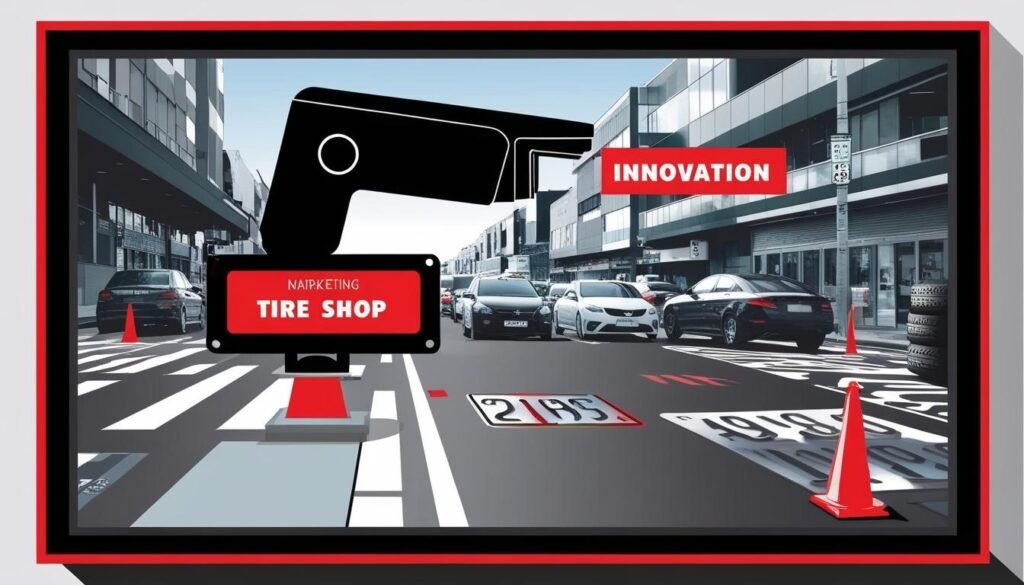As independent tire dealers face increasing challenges in customer acquisition and loyalty, innovative solutions like license plate recognition technology emerge as a key tool for effective marketing.
Independent tire dealers are facing a growing challenge as they strive to attract new customers while maintaining loyalty among their existing client base. Central to this challenge is lead generation; without a consistent influx of potential customers, even the most skilled technicians at reputable shops may struggle to expand their business beyond their established clientele.
Recent advancements in technology have introduced new solutions to this age-old problem. Among these, license plate recognition (LPR) technology is emerging as a noteworthy tool to bolster lead-generation efforts for tire shops. Companies like Digital Recognition Network (DRN) are at the forefront of this innovation, harnessing LPR technology in combination with opt-in marketing databases to facilitate a deeper understanding of traffic patterns and consumer behaviour.
Noel Peña, senior executive director at DRN, elaborates on how the technology operates. DRN’s LPR system is available in two configurations: mobile and fixed. The mobile system employs cameras mounted on vehicles designed to scan license plates while traversing various locales, functioning similarly to Google’s mapping vehicles. This information, once compiled into a comprehensive database, aids lenders in tracking vehicles associated with delinquent accounts for collection and repossession purposes.
On the other hand, DRN’s fixed camera system, referred to as “driven insights,” serves as a marketing solution for businesses. This system captures license plates, decodes them to find the vehicle’s identification number, and appends relevant opt-in marketing data to the business’s profile. Peña remarked, “The important part of what we’re doing is allowing the company’s marketer to take in the data that’s relevant to their business and then figure out how to build their marketing channels around it.”
These practices raise questions about privacy; however, Peña clarifies that DRN is compliant with legal standards as the company only gathers data from vehicle owners who have granted permission. “Our end-users are only looking to target people who have opted-in to a database, they accepted those service conditions,” he explains.
The implications of LPR technology for tire shops are considerable. By analysing the data collected, shops can refine their marketing strategies and outreach to specific demographics. Peña suggests that, instead of relying on generalised marketing tactics, independent tire shops could tailor their campaigns more closely to their immediate community. For instance, a promotional campaign aimed at local families could focus on households within a two-mile radius, fostering a more personal connection with potential customers.
Moreover, Peña points out practical applications of the LPR data, such as targeting promotions on surplus inventory or tailoring offers to vehicle types that frequently pass by the shop. Data insights, including odometer readings, might also inform tire dealers about potential wear and tear on vehicles, enabling targeted messaging based on vehicle condition and usage.
As the tire industry experiences continuous transformation, independent dealers must embrace innovative strategies to attract new clients and retain their current customer base. LPR technology, when integrated with opt-in marketing data, offers a promising pathway for shops to enhance their marketing efforts, ensuring they remain competitive not just against local rivals but also against larger national chains. This advancement could provide independent tire shops with the crucial edge needed to navigate a rapidly changing business landscape.
Source: Noah Wire Services
- https://www.motor.com/2022/02/how-tire-dealers-can-improve-tire-visibility-in-the-supply-chain/ – This article discusses the use of technology, such as mobile data capture and license plate scanning, to improve efficiency and data collection in tire dealerships, which is relevant to the integration of advanced technologies in the tire industry.
- https://www.moderntiredealer.com/site-placement/featured-stories/article/11466244/analysis-the-3-top-issues-tire-dealers-should-track-in-2022 – This article highlights key challenges faced by independent tire dealers, including technician retention and access to product/inventory, which are crucial for maintaining and expanding their customer base.
- https://anyline.com/use-cases/tire-ecommerce – This page explains how mobile data capture solutions, such as tire scanning and license plate scanning, can be integrated into tire e-commerce platforms to enhance customer experience and operational efficiency.
- https://gaintractionpodcast.com/focusing-on-helping-independent-tire-dealers-with-mike-burns/ – This podcast episode discusses strategies for independent tire dealers to grow and thrive, including the importance of networking, continuous learning, and leveraging collective experience, which aligns with the need for innovative marketing strategies.
- https://www.moderntiredealer.com/site-placement/featured-stories/article/11466244/analysis-the-3-top-issues-tire-dealers-should-track-in-2022 – This article emphasizes the importance of e-commerce initiatives for tire dealers, which is relevant to using data insights to tailor marketing campaigns and enhance online presence.
- https://anyline.com/use-cases/tire-ecommerce – This resource details how tire scanning and vehicle identification solutions can help in targeting specific demographics and enhancing marketing strategies, similar to the use of LPR technology.
- https://www.motor.com/2022/02/how-tire-dealers-can-improve-tire-visibility-in-the-supply-chain/ – This article discusses the integration of mobile technology to optimize processes, which is similar to the use of LPR technology for marketing and data collection purposes.
- https://gaintractionpodcast.com/focusing-on-helping-independent-tire-dealers-with-mike-burns/ – This podcast highlights the growth and expansion strategies of the Independent Tire Dealer Group, which includes leveraging technology and collective resources to stay competitive.
- https://anyline.com/use-cases/tire-ecommerce – This page explains the secure data processing aspect of mobile data capture solutions, which is similar to the privacy compliance mentioned in the use of LPR technology.
- https://www.moderntiredealer.com/site-placement/featured-stories/article/11466244/analysis-the-3-top-issues-tire-dealers-should-track-in-2022 – This article stresses the need for tire dealers to adapt to changing market conditions and consumer behaviors, which aligns with the necessity of innovative marketing strategies using LPR technology.
- https://anyline.com/use-cases/tire-ecommerce – This resource provides examples of how combining different scanning solutions can enhance marketing and operational efficiency, similar to the integrated use of LPR and opt-in marketing data.


